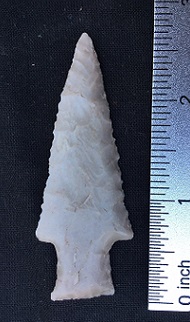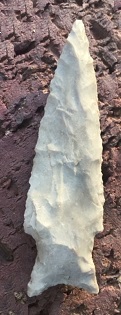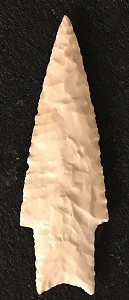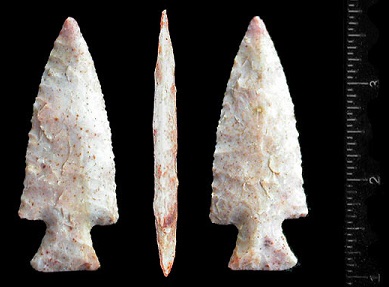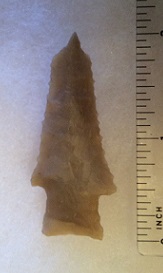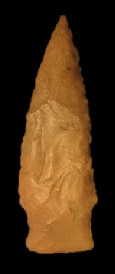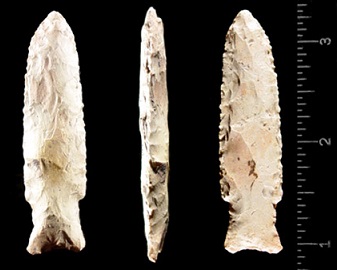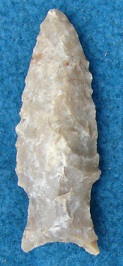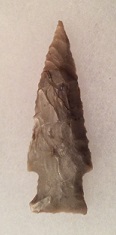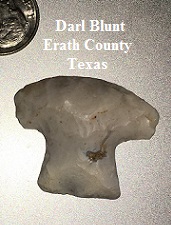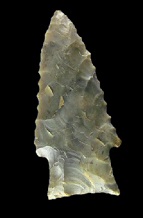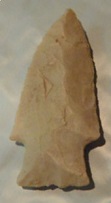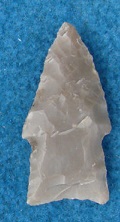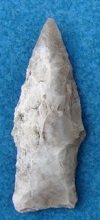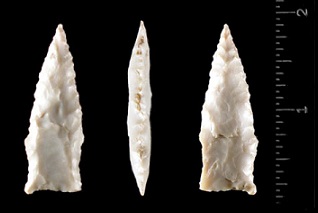Outline is Representative of Size and Shape:
 Straight
Straight
Stem
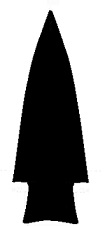 Expanding
Stem
Expanding
Stem
Stem
Name Details:
Identifd By: E. O. Miller and Edwards B. Jelks
Named For: Darl Hill (local collector)
Date Identified: 1952
Type Site: Belton Reservoir, Coryell County, Texas
Identifd By: E. O. Miller and Edwards B. Jelks
Named For: Darl Hill (local collector)
Date Identified: 1952
Type Site: Belton Reservoir, Coryell County, Texas
Point Validity:
Valid type
Jelks was a distinguished anthropologist and helped organize the newly formed Department of Anthropology at Illinois State University where he was a Professor. His work in Texas furthered the understanding of Texas archeology and was a founding force for the Society of Historical Archeology. This point was named in a professional publication and has many professional references. This is a valid type.
Jelks was a distinguished anthropologist and helped organize the newly formed Department of Anthropology at Illinois State University where he was a Professor. His work in Texas furthered the understanding of Texas archeology and was a founding force for the Society of Historical Archeology. This point was named in a professional publication and has many professional references. This is a valid type.
Darl Stemmed
AKA: Brazo StemmedCluster:
Description of Physical Characteristics and Flaking Pattern:
This is a narrow medium triangular expanding stemmed to stemmed point with an elliptical cross section. The blade is long, narrow and slightly excurvate to straight. This point is commonly has a steep right edge beveled on both faces and finely serrated on both beveled and un-beveled examples. Many examples have right hand beveling on one edge on each face of the point. The shoulders may vary from weak to prominent and range from horizontal to having an upward angle, rarely are the shoulders slightly barbed. The stem may range from straight to slightly expanding and is typically beveled, but lacks basal or hafting region grinding or smoothing. The base is most commonly convex, but may vary to straight. This point has a random flaking pattern.
Size Measurements:
Length - 25 to 70 mm (50 mm average), Stem Length - 12 to 22 mm (typically the stem makes up 1/6 to 1/2 the total length), Width - 10 to 15 mm
Length - 25 to 70 mm (50 mm average), Stem Length - 12 to 22 mm (typically the stem makes up 1/6 to 1/2 the total length), Width - 10 to 15 mm
Commonly Utilized Material:
Additional Comments:
Story (1990), suggest that the Kent and Woden points are variants of the Darl point.
Elton Prewitt (1981) divided the Darl point into two variants; the Mahomet and the Zephyr sub-types. See the Zephyr page for descriptions of both types.
Dwain Rogers (personal communication) mentions that these points are commonly found in layers directly below arrow type points suggesting that these may have been the last darts used in the area before the transition to arrows.
This point is similar to the Yarbrough point, but differs in the Darl point has a beveled blade which is lacking on the Yarbrough point. The Darl point lacks hafting region smoothing which is seen on the Yarbrough point (Bell, 1958)
Story (1990), suggest that the Kent and Woden points are variants of the Darl point.
Elton Prewitt (1981) divided the Darl point into two variants; the Mahomet and the Zephyr sub-types. See the Zephyr page for descriptions of both types.
Dwain Rogers (personal communication) mentions that these points are commonly found in layers directly below arrow type points suggesting that these may have been the last darts used in the area before the transition to arrows.
This point is similar to the Yarbrough point, but differs in the Darl point has a beveled blade which is lacking on the Yarbrough point. The Darl point lacks hafting region smoothing which is seen on the Yarbrough point (Bell, 1958)
Distribution: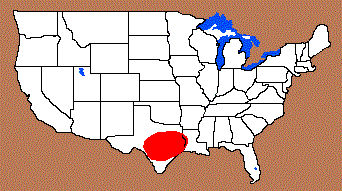
Distribution Comments:
This point is primarily found in central Texas and into the lower Pecos region and east into the Coastal Plains. This point may be found into western Louisiana with decreased frequency. Bell (1958) places this type into central and western Oklahoma.
This point is primarily found in central Texas and into the lower Pecos region and east into the Coastal Plains. This point may be found into western Louisiana with decreased frequency. Bell (1958) places this type into central and western Oklahoma.
Age / Periods:
Date: 2,500 - 1,300 B.P.
Cultural Period:Transitional Archaic
Glacial Period: Roman Warm to Vandal Minimum
Culture:
Date: 2,500 - 1,300 B.P.
Cultural Period:Transitional Archaic
Glacial Period: Roman Warm to Vandal Minimum
Culture:
Age Details:
Other points in this custer / Related / Associated Points:
Darl Blade, Darl Stemmed, Mahomet, Zephyr
Darl Blade, Darl Stemmed, Mahomet, Zephyr


